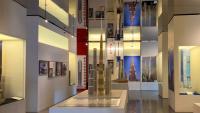Wuyishan Bamboo Raft Factory
Wuyishan, China
The Wuyishan Bamboo Raft Factory is a storage and manufacturing facility which produces bamboo rafts used to sail the Nine Bend River in Wuyi Mountain. The project sits atop a plateau surrounded by country fields in Xingcun village, Wuyi Mountain. The three buildings on site – a bamboo raft storage warehouse, a bamboo manufacturing workshop, and an office and dormitory building – are knit together by a central courtyard. Each winter harvest yields 22,000 bamboo stems which, following a storage period in the workshop, are used to manufacture 1,800 bamboo rafts annually.
The architecture and layout reflect distinct functional, topographical, and climate demands. Bamboo stems occupy the main courtyard, where they are arranged according to prevailing wind directions in order to achieve optimal ventilation. The depths of the surrounding buildings are tailored to maximize courtyard space and allow greater penetration of natural light into the interior. The warehouse, placed along the southwest side of the site, extends the overall expression of linearity. The manufacturing workshop is divided into two work units. The interior, with its long span and open layout, accommodates the nine meters of width required for firing. Lengthwise, the space supports three to four manufacturing units which specialize in burning and bending the bamboo tail and head, and the final binding parts of the production process. Natural light is filtered through oblique skylights, which are oriented northward in order to prevent glare. Smaller spaces form rest areas, storage, restrooms, courtyards, and other service functions. Sloping roofs are used throughout to improve irrigation and roof insulation. The office and dormitory building adopts a veranda layout, with offices occupying the first floor, and dormitory and cafeteria occupying the second floor. Bamboo stalks are applied along the veranda to form shading louvers, which also provide well-ventilated insulation.
The architecture is constructed from concrete, bamboo, wood, and other local materials. Fresh water concrete is used for the structure, and hollow concrete blocks build up the wall system. Since the factory building does not require heat preservation, its outer walls are made with horizontally-laid hollow bricks, which also provide adequate ventilation. The industrial character of the project discourages superfluous design; by using the most basic elements for its construction, the architecture naturally reveals its structural and material logic. The project reconciles aesthetic simplicity with an economy of means, by which the architecture can demonstrate its resolution of form and function.
















